If you use it correctly, emails is still a very powerful outreach tool, especially when you are reaching out to strangers – in other words writing a cold email. People can get easily annoyed with cold calls and unsolicited connection request are not usually welcome on social media. But someone’s inbox is still comparatively more approachable, if you can write you write your email in a correct way.
So what is this correct way of sending cold emails?
Generally, there are some pointers to be followed –
- Subject lines should be personalized. They should establish credibility or curiosity or both.
- Email text as well as the subject line should be clear and concise
- If you are sending cold emails on a large scale, you should take care of your sender reputation and regularly check deliverability of your emails.
- It is difficult to get someone’s response on the very first cold email. Therefore it is important that you send a sequence of cold emails, following up at regular intervals.
There are many templates available for sending cold emails. But what about the subsequent follow up emails? Are there any thumb rules or templates for sending a sequence of cold emails in different situations?
Let’s look at a few such cold email sequence templates.
Table Of Contents
1. Cold email sequence templates
1.1 Truly cold email
1.2 Cold email to website visitor
1.3 Cold email to someone you met recently
1.4 Reaching out to people you found from news, blogs, social media etc.
2. Automate your cold email sequences
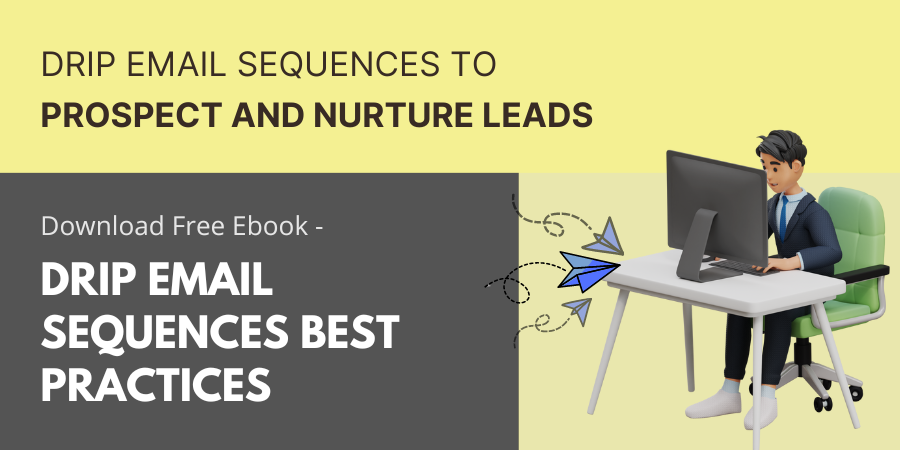
Cold email sequence templates
People write cold emails for different purposes – sales, job hunting, fund raising, networking to name a few. Your cold email content will change depending on the reason why you are reaching out.
Your cold email template also depends on how you came across a person – did you meet them at a conference or did they visit your website.
Consider all these underlying factors, when selecting a cold email sequence template for your own situation.
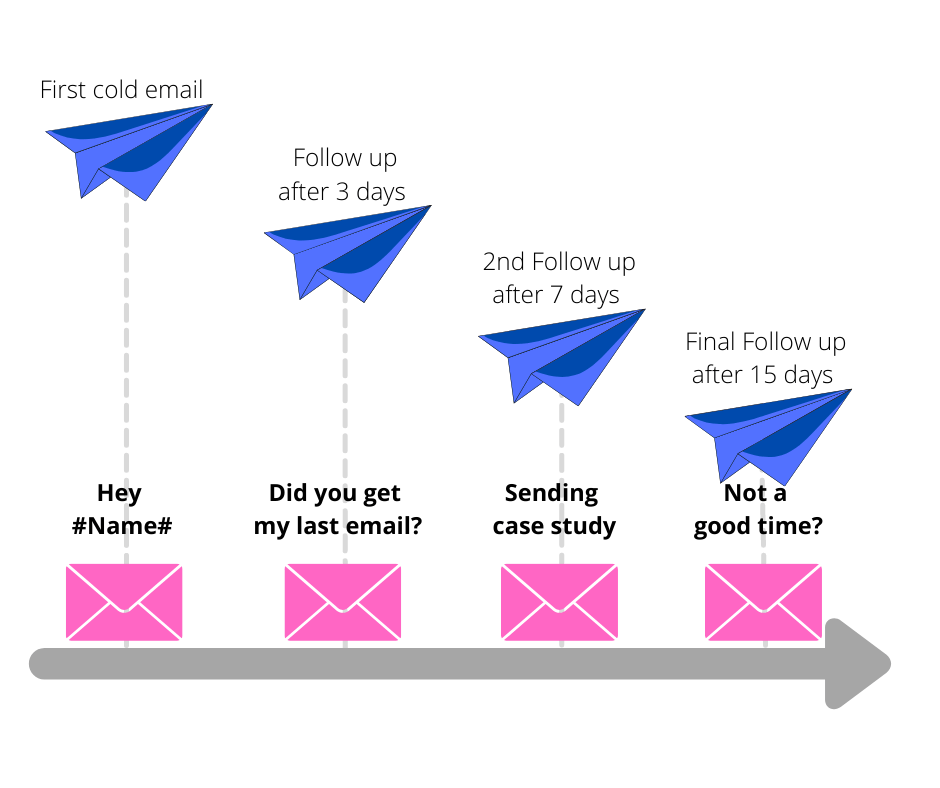
Truly cold email
Use this cold email sequence template when you want to reach to complete strangers, people who you have never met before. You may have go their email address from their website or industry directory or some other place. But essentially they have no idea who you are.
So your very first email should try to establish some sort of common ground. Because most people are busy and don’t take out time to read emails which are completely unrelated to them.
It’s absolutely important some sort of connection in the first email and then try to build on it in the subsequent emails. It is also important to write a very clear and direct subject line. Because on one is going to spend more than 2 seconds trying to figure our what your email is about.
If you have any existing customers who are well known in your target industry, use their name to establish familiarity as well as credibility.
Email 1 – Introduction
 |
| Subject: We helped {{existing customer name}} with {{your area of expertise}} |
| Hi {{first name}}, My name is {{your name}} with {{your company}}. We help {{specific business type}} with {{your area of expertise}}. We recently worked with {{existing customer name}}. I wanted to check how you are currently running {{your area of expertise}} at {{company name}} and if we can help out in some way. Are you available for a brief call on sometime this week? Warm regards, {{Your Name}} |
 |
Email 2 – Follow up after a week, by replying on the first email
 |
| Subject: Re: Did you get my last email? |
| Hi {{first name}}, I know sometimes emails can get lost in heaps of other messages. So just wanted to quickly check if you received my last (trailing email). I wrote to you about how we helped {{existing customer name}} with {{your area of expertise}}. Can we connect for a quick call sometime this week to check if we can possibly help your team as well? Warm regards, {{Your Name}} |
 |
Email 3 – Final follow up, send a case study
 |
| Subject: Re: I will leave you with this case study |
| Hi {{first name}}, Earlier, I wrote to you about how we helped {{existing customer name}} with {{your area of expertise}} and if we could possibly help your team in the same way. But it doesn’t seem like this is the right time for you to discuss this. So we are going to leave you with this case study, specifically documenting how we were able to help {{existing customer name}} – {{link to the case study document}} Let me know whenever you are ready to discuss about {{your area of expertise}} at {{company name}}. Warm regards, {{Your Name}} |
 |
Important points to note
- Since you don’t have any communication history with this person, it’s not a good idea to send more than 3-4 cold emails. You will mostly be wasting your time, risking getting your email address flagged as spammer.
- For the same reason, you also don’t want to send your follow up emails in quick succession. Space them out at least 4-5 days apart. You will find more pointers here – to correctly time your follow up emails.
- Leave the recipient with some educational material about your product / service. In most cases people don’t answer your cold emails because they are busy with other things and the timing is not right for them to discuss your specific offering, for example – sales. But whenever they start to think about “sales” in the future, they should have your case study / video / brochure handy to read about you and reach out to you.
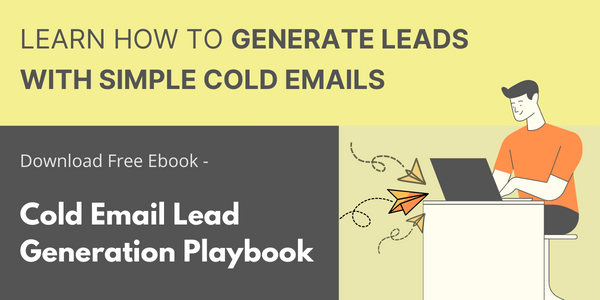
Cold email to website visitor
If you run an online business, your business website is the best place to capture new leads. You can offer valuable resources (lead magnets) to your website visitors, in exchange for just their email address.
Then send them a sequence of emails to educate them about your product / services.
This type of cold emails is more likely to be effective since the website visitors you are targeting, have already shown an interest in your area of operation by downloading your lead magnet – ebooks, case studies, or other such free resources.
When you write your first email, your foot-in-the-door is going to be the downloaded document. Use this cold email sequence template to first establish familiarity with the reader and then keep pulling on the same thread with follow up emails.
Email1 – Ask about the downloaded document
 |
| Subject: I hope we were able to help |
| Hi {{First Name}}, I noticed that you recently visited {{your website}} and downloaded {{document title}}. I hope we able help with your {{area of your expertise}} at {{company name}} 🙂 We created {{document title}} because we saw so many of our customer struggle with the same problem of {{problem you are solving}}. So we wrote the document to help them along with our {{product / service}}. If you found it useful, you should also check out our {{product / service}}. Let me know if you are available for a quick zoom call this week, I will help you explore it in details. Best, {{Your Name}} |
 |
Email2 – First follow up, after 3-7 days
 |
| Subject: Re: putting {{lead magnet name}} in practice |
| Hi {{First Name}}, Emails can often get buried in heaps of other messages. So I just wanted to check if you got my last email. I wrote to you about our {{product / service}} which essentially just enables the execution of the best practices we have written about in {{lead magnet name}}. Would you like to explore more details about it? We can connect for a quick zoom call or your can try it out from – {{link to you product service}} Best, {{Your Name}} |
 |
Email3 – Second follow up, after 5-10 days
 |
| Subject: Let me know if we can help with anything else |
| Hi {{First Name}}, I really hope that you found our {{lead magnet name}} useful. Our {{product / service}} helps you put the very same ideas into practice. Although I think now is not the best time for you to explore it, let me know whenever you want to connect for a quick call and I will be happy to share with you how we can help {{company name}}. In the meantime, let me know if there’s anything else we can help with 🙂 Best, {{Your Name}} |
 |
Important points to note
- Keep your communication focused around the subject of the lead magnet. Because that subject is already of interest to your audience for this cold email campaign.
- Make sure your lead magnet documents are closely related to your products / services. Otherwise you will draw in a lot of new leads, who will not convert because of the disconnect between their expectations and your offering.
Cold email to someone you met recently
You may also get new leads through industry conferences, trade shows and other such events. Once you have their contact details, you can try and reconnect with them using the following cold email sequence template.
Email1 – We connected at {{event name}}
 |
| Subject: Hi {{First Name}}, we connected at {{event name}} |
| Hi {{First Name}}, It’s {{your own name}} from {{your company name}}. We recently connected at {{event name}}. I did enjoy our brief exchange on {{your area of expertise}} and wanted to follow up on that by sharing a few more details of what our team has been up to lately. {{recent projects / news / highlights}} I thought you would find it interesting and also useful for your team at {{company name}}. Would you like to connect for a quick call and go over the details? Best, {{Your Name}} |
 |
Email1 – Follow up 1, ask about coffee
 |
| Subject: Hey {{First Name}}, catch up over coffee? |
| Hi {{First Name}}, How are you? I hope you were able to go over the details I shared with you last week about {{recent projects / news / highlights}}. When we met last at {{event name}}, I got the impression that you would be interested in improving {{area of your expertise}} with proven tactics. Can I buy you a coffee sometime this week? Then we can also chat about the details. Warm regards, {{Your Name}} |
 |
Email1 – Follow up 2, going to {{next event}}
 |
| Subject: Will I see you at {{next event}} |
| Hey {{First Name}}, It was a please to connect with you at {{last event name}} last time. I am planning to go to {{next event}} next week and was wondering if I will see you there. It will be great to catch up again. Looking forward to seeing you soon 🙂 Warm regards, {{Your Name}} |
 |
Important points to note
- If you frequently meet your audience at conferences and trade shows, there’s no point in being pushy in your emails. Use your emails with a casual tone to build a relationship for the long term.
- Use this cold email sequence template to share your recent projects or achievements that can generate genuine interest in your audience.
Reaching out to people you found from news, blogs, social media etc.
But not cold email campaigns are sales related. You may at times also reach out to people for funds, jobs and even their time contribution to a cause. Let’s then look at a cold email sequence template, that’s not sales related.
Social media is a great place to connect with like minded people. But you can find like minded people even through other online channels or even traditional news media.
Let’s say you volunteer at some non-profit and you recently came across someone’s blog. That person also works in the same field and want to reach out and ask for their help. You can do that using this series of cold emails.
Email1 – Appreciate their recent work
 |
| Subject: Loved your {{blog / newspaper article / social media post}}! |
| Hey {{First Name}}, How are you? Earlier today, I saw your {{blog / newspaper article / social media post}} and absolutely loved it! I also happen to {{mention your activity in the similar non-profit cause}}. We are a small but passionate team at {{your organization}}. But recently we have been overwhelmed and could really appreciate an extra pair of hands. Would you be interested? Looking forward to connect and chat soon 🙂 Best, {{Your Name}} |
 |
Email2 – Send some photos of your recent work
 |
| Subject: Re: sharing some of our recent work at {{your organization}} |
| Hey {{First Name}}, Hope you’re doing great. Earlier I had written to you about {{mention your activity in the similar non-profit cause}}. I thought you might also appreciate some of the work we did recently, so sharing some pics with you – {{photos}} Also, I know you might also be busy. But we are planning for some activities next month, that you’ll find really interesting. Let me know if you would like to connect and chat more. Best, {{Your Name}} |
 |
Important points to note
- When you approach someone on behalf of a non-profit organization or a social cause, there’s absolutely no point in being overly pushy. Those people who are interested in contributing will do so after the first 2-3 emails.
- Also it’s good to keep in mind that you are essentially requesting someone’s spare time and resources. So better give them sufficient time to respond to your requests.
Automate your cold email sequences
You can use these cold email sequence templates as a reference or a starting point and then customize them to suit your own specific situation. Finally when you create your own series of emails, you can start by sending them manually to new leads and test their responses.
Needless to say, you will only send these email sequences till people respond to one of them. When someone responds to your cold emails, you should stop the sequences for that particular person.
Over time, you will be able to learn how people respond to different messages, what works in your situation and what doesn’t. At that point, it’s a good idea to use a cold email automation tool to scale up your cold email outreach. You can use a basic mail merge tool for sending your emails at scale, one email template at a time. But you if you want to automate the sequential sending of emails, if you need a drip email or cold email automation workflow.
SafeMailer creates a drip email automation workflow within your Google Drive by connecting your Google Sheets (used to manage mailing lists), Google Docs (used as email templates) and Gmail (for periodically sending your personalized cold emails).
Since SafeMailer combines a mail merge workflow with scheduled campaigns, it doesn’t send emails in bulk. But your cold emails are sent in a staggered manned, improving their deliverability and landing majority of your cold emails in INBOX.
You can take a 7 day free trial or start with a free plan and see if this cold email automation workflow is useful for your email outreach.
If you are not ready to try out the software just yet, you can start by exploring the best practices of cold emailing or how you can use cold emails effectively, for lead generation. Once you go over those basics, you will be in a better position to use any cold email sequence template from above.

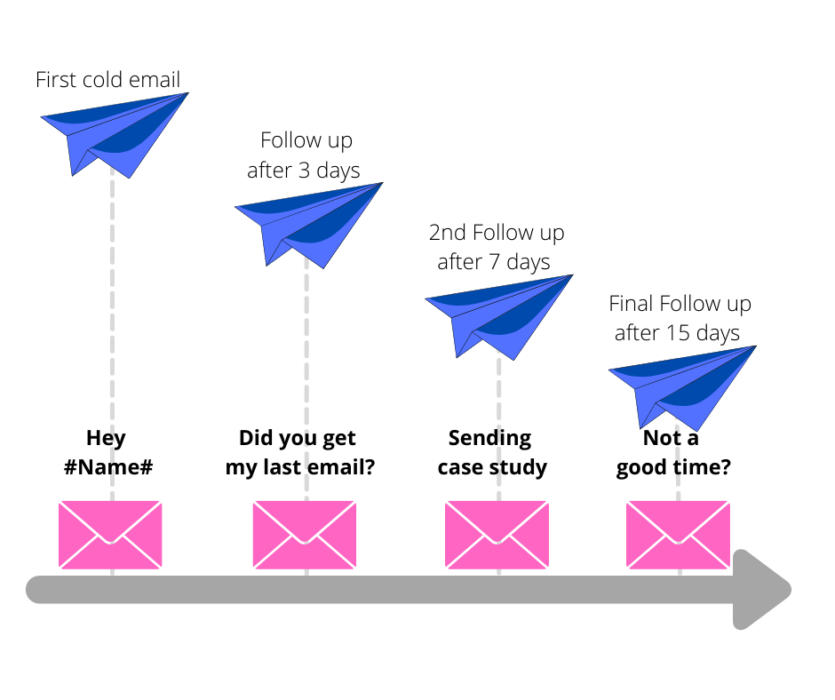
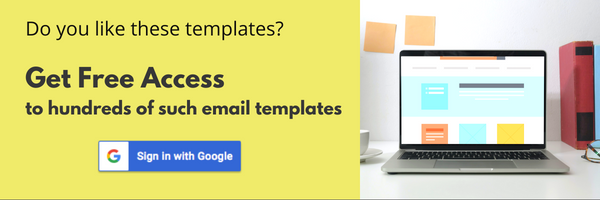
Leave a Reply